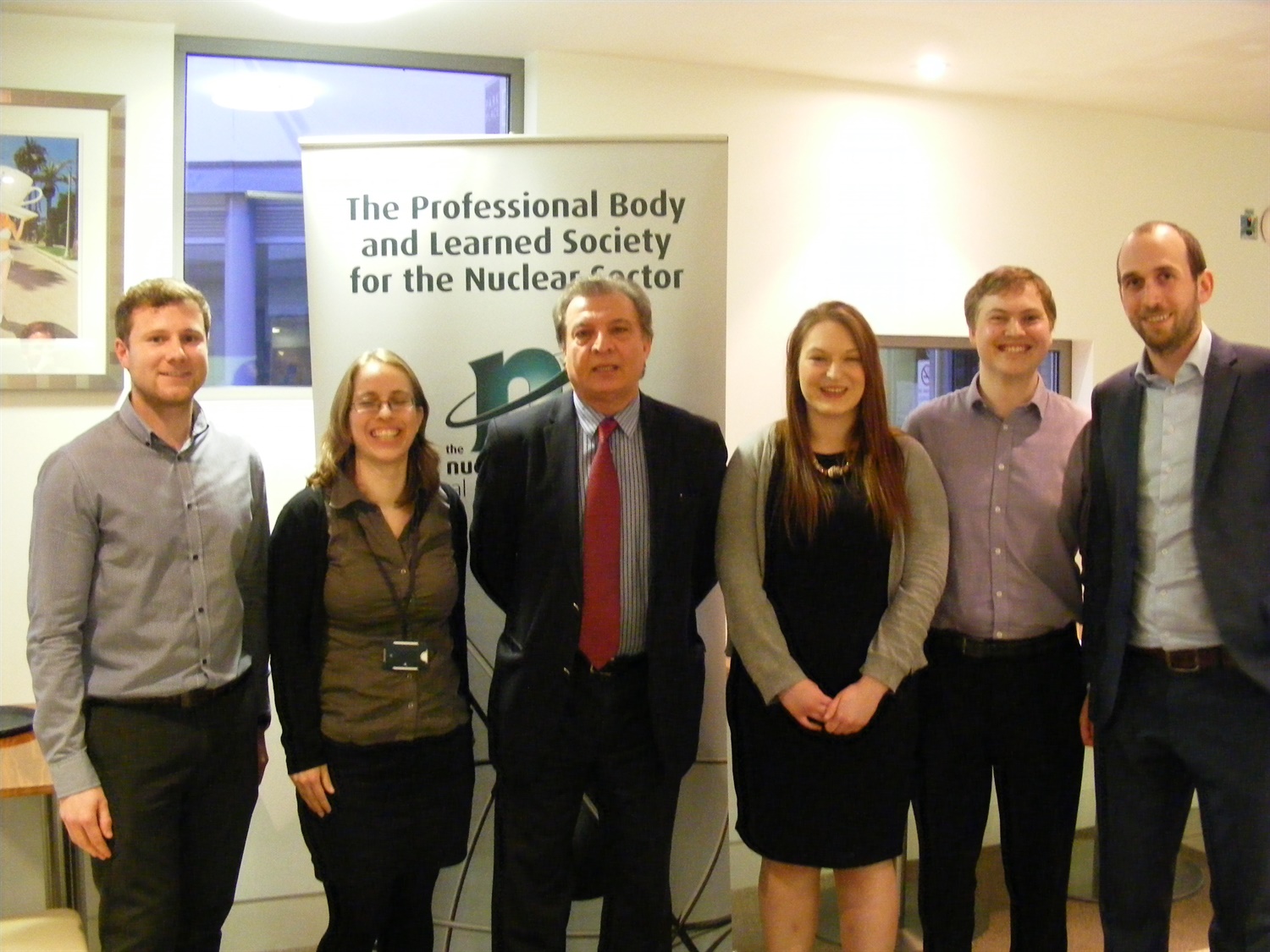
Great topic diversity and high standards from all the finalists in the Central England heat of the YGN National Speaking Competition
The key objective of this Nuclear Institute Central England Branch event, held on 31 March 2016, was to give our five regional finalists the opportunity to demonstrate their communication skills before a live audience, with emphasis on how the chosen subject was presented. First, second, third and fourth-equal places were awarded.
Our five judges provided extensive experience encompassing advanced nuclear fuels, fusion, remote handling, radiation effects in materials, radiation damage studies, fast reactor reprocessing chemistry, waste management and nuclear decommissioning. They were therefore well placed to assess the very interesting, thought provoking and diverse topics presented by our finalists.
Marks were awarded for four aspects: Synopsis; Oral Presentation; Clarity and Use of Visual Aids; and, Ability to Explain to a Non-Technical Audience. The judges decided that aspects two and three were the most important in the context of the key objective and weighted the marking accordingly (5,10, 10, 5), giving a maximum possible score of 30. The target presentation time was 10 minutes.
In the spirit of Continued Professional Development (CPD), a private and confidential feedback report has since been provided to each finalist.
The competition was introduced and conducted by Dr. Mehdi Askarieh, Chairman of Central England Branch. Each presentation was followed by a lively and informative question and answer session. The judges and the audience were very impressed by the quality of all the presentations. Marks scored were very close and it was difficult to choose between them. All presentation timings were excellent and all speakers demonstrated good audience rapport.
After very careful consideration, first place (and a £300 prize) was awarded to Stevie Wray of UKAEA who gave an overview of ' Grid Scale Energy Storage - What Are Our Options?', providing a very clear and helpful run through the various options available. He concluded by noting that it looks economically viable to run an energy storage facility with the current market setup, but the business case is marginal. In the future, we may see a lot of energy storage on the grid, but the market conditions need to be right to attract the investment required to make it happen. The audience suggested that a follow-up talk on the viability of each method would be welcomed!
Second place (and a £200 prize) went to Saralyn Thomas of Areva-RMC for her presentation "D' oh": 'The Sound of Safety Culture in Springfield'. Saralyn described the different elements that contribute to a strong safety culture (an informed, reporting, learning, flexible and just culture) and explored these through examples of poor safety culture in 'The Simpsons' (especially Homer) with potential improvements identified. This was an amusing approach to a difficult area and was very good at getting key points across. A serious and important subject was presented in a way that was light-hearted, relevant and humorous, with the added bonus of being able to capture the interest of the general public.
Third place (and a £100 prize) was awarded to Stephen Blaxland of AWE Aldermaston for his easy to understand non-technical outline of 'Machine Learning Within Nuclear Forensics'. This potentially complex topic was well described by Stephen, who explained that nuclear forensics is the practice of examining the “nuclear fingerprints” of a material to determine its identity and provenance. He pointed out that, historically, nuclear forensics has relied upon experimental techniques performed and analysed by experts, however, times are changing. There is a recent growth in machine learning algorithms that can successfully learn how to determine the origin of a source by analysing patterns in historical data. These algorithms have the potential to greatly aid experts to determine the origin of a new, unknown sample.
We then had the difficult challenge of deciding fourth and fifth places. After much deliberation, the judges decided on fourth-equals for Eva Belonohy of Culham Centre for Fusion Energy (CCFC) and James Pearson of Amec Foster Wheeler.
Eva described 'The Joint European Torus(JET): A Gateway to Fusion Energy', using well-chosen images, summary texts and effective use of analogy. She gave an enthusiastic and clear explanation of the 'open' fusion community and a concise non-technical description of JET as 'a small sun'. Eva explained that JET is developing the best achievable fusion performance scenarios to be used in the first ever experimental fusion reactor being built in the South of France, seeking to prove that fusion energy is a cheap, safe alternative nuclear energy source that can provide a possible solution to the world’s energy problems.
James described 'The Concept of Deep Borehole Disposal for Nuclear Waste', in a well-structured presentation that was logical and clearly explained. The range of wasteforms was outlined, ranging from contaminated concrete and metals, to highly active liquor from the reprocessing of spent fuel; noting that these wastes can remain hazardous for thousands of years, and produce large levels of heat, both of which require careful management over a time period that cannot be maintained from man-made stores. Borehole design was described, including the envisaged significant depth, which is thought to provide a solution that is totally isolated from human activity, with little potential of radioactive substances returning to the surface. James outlined the programme being undertaken in the USA, and offered his thoughts on how borehole concepts could be utilised for various wasteforms in the future.
All the presentations were very interesting, capturing and holding the attention of the audience. In closing the proceedings, Dr. Askarieh congratulated each finalist on a job very well done. The photograph shows Dr. Askarieh with (from left to right) James Pearson, Eva Belonohy, Saralyn Thomas, Stevie Wray and Stephen Blaxland.
We thank all our finalists, judges and audience for a very enjoyable and stimulating regional final and offer Stevie our very best wishes for the National final. Our thanks also go to the Nuclear Institute and to the YGN for continuing to support this important and career-enhancing competition.
Central England Branch
Nuclear Institute